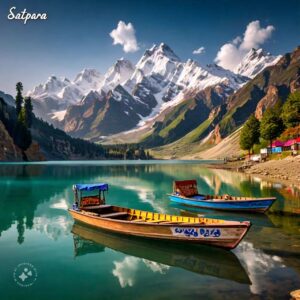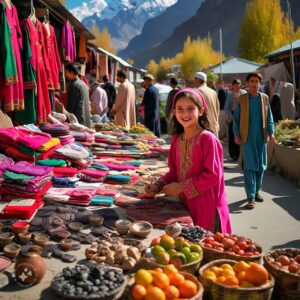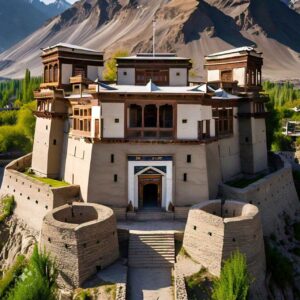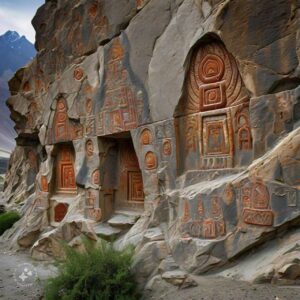Skardu, Gilgit-Baltistan:
Skardu, nestled in the heart of Gilgit-Baltistan, is a breathtaking paradise of serene lakes, towering peaks, and vibrant valleys. This picturesque town, framed by the majestic Karakoram Range, serves as the gateway to some of the world’s highest mountains, including K2. The crystal-clear waters of Satpara and Shangri-La Lakes reflect the surrounding snow-capped peaks, creating scenes of unparalleled beauty. Historic forts like Skardu Fort and Shigar Fort provide a glimpse into the region’s rich heritage, while the warm hospitality of the local Balti people adds to the charm of this enchanting destination. Whether it’s trekking through verdant valleys, marveling at ancient glaciers, or simply soaking in the tranquil atmosphere, Skardu is a haven for nature lovers and adventurers alike. Skardu is a picturesque town nestled in the Gilgit-Baltistan region of northern Pakistan. It serves as the gateway to some of the world’s highest peaks and is surrounded by breathtaking landscapes. Here are some detailed aspects of Skardu:
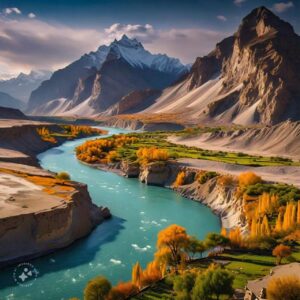
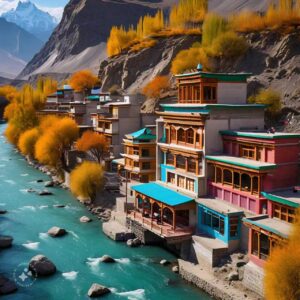
- Location and Accessibility, Skardu, Gilgit-Baltistan:
- Skardu is located at an altitude of approximately 2,228 meters (7,310 feet) above sea level.
- It lies in the Skardu District of Gilgit-Baltistan, which is accessible by road from Gilgit (a journey of about 7-8 hours) and by air via Skardu Airport.
- Scenic Beauty of Skardu, Gilgit-Baltistan:
- Skardu is renowned for its stunning mountain scenery, nestled amidst the Karakoram Range. The peaks of Masherbrum, K2, and Broad Peak are visible from various points in the town.
- The Indus River flows through the Skardu Valley, adding to its natural beauty.
- Tourist Attractions of Skardu, Gilgit-Baltistan:
- Shangri-La Resort: Located about 35 kilometers from Skardu, Shangri-La Resort (also known as Lower Kachura Lake) is famous for its serene lake with crystal-clear waters and the “Shangrila Resort” built on the lakeside.
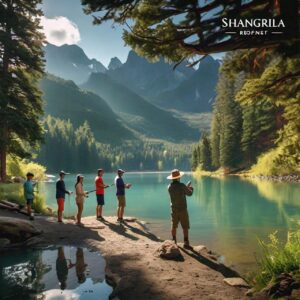
Shangri-La Resort: - Upper Kachura Lake: Situated further up from Shangrila Resort, Upper Kachura Lake offers even more pristine views of the surrounding mountains and is known for its tranquility.
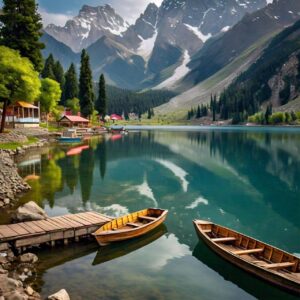
Upper Kachura Lake: - Satpara Lake: A beautiful lake located near Skardu, Gilgit-Baltistan, often visited for its turquoise waters and panoramic views.
- Shangri-La Resort: Located about 35 kilometers from Skardu, Shangri-La Resort (also known as Lower Kachura Lake) is famous for its serene lake with crystal-clear waters and the “Shangrila Resort” built on the lakeside.
- Adventure and Trekking of Skardu, Gilgit-Baltistan:
- Skardu, Gilgit-Baltistan is a popular starting point for treks to various base camps in the Karakoram Range, including the trek to K2 Base Camp.
- Other treks from Skardu lead to places like Concordia (where the Baltoro Glacier meets the Godwin-Austen Glacier) and the trek to Gondogoro La Pass.
- Culture and Hospitality of Skardu, Gilgit-Baltistan:
- Historical Sites of Skardu, Gilgit-Baltistan:
- Skardu Fort (Kharpocho Fort): A historic fort overlooking the town, offering panoramic views of Skardu and the Indus Valley.
- Buddhist Rock Carvings: Near Skardu, there are ancient rock carvings and Buddhist artifacts that highlight the region’s historical significance.
- Climate of Skardu, Gilgit-Baltistan:
- Skardu experiences a cold desert climate with chilly winters and mild summers. The best time to visit is during the summer months (June to September) when the weather is more temperate and trekking routes are accessible.
Skardu, Gilgit-Baltistan is not only a gateway to the towering peaks of the Karakoram but also a destination in itself, offering a blend of natural beauty, adventure opportunities, cultural richness, and historical significance that attracts travelers from around the world.

